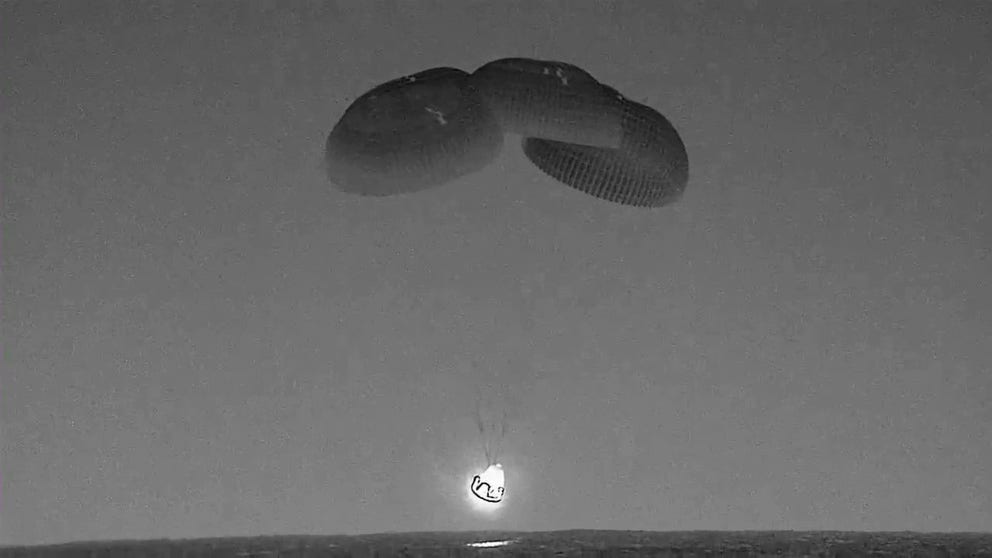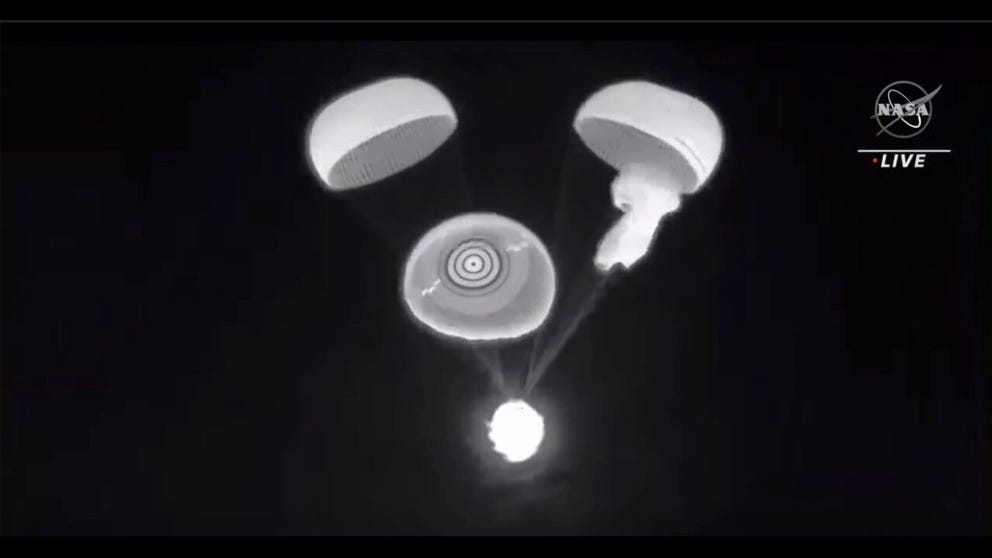Weather is critical for a safe SpaceX Crew Dragon splashdown
NASA and SpaceX have seven potential Dragon landing sites around Florida. The splashdown site is chosen based on the forecast.
SpaceX Dragon spacecraft returns to Earth with 4 astronauts
The Dragon capsule zoomed by Florida on Monday morning returning to Earth with four astronauts after a 6-month mission on the International Space Station. The spacecraft could be seen on both Florida coasts and safely splashed down in the Atlantic Ocean.
SpaceX's astronaut spacecraft Crew Dragon launches on a reusable Falcon 9 rocket indicative of the commercial space era, but it returns to Earth with an old-school landing and an Apollo-era-like splashdown.
Elon Musk's company and Boeing were selected under NASA's Commercial Crew Program to shuttle astronauts to and from the International Space Station. SpaceX has completed six such trips with professional astronauts and launched a seventh for NASA in August. The private company also conducted Inspiration 4, the first all-civilian spaceflight that did not dock at the station but instead orbited the Earth for three days. SpaceX is also contracted with Axiom Space to launch private astronaut missions to the space station, with two successful missions completed by 2023.
All Dragon spaceflights end with the capsule splashing down off either Florida coast.
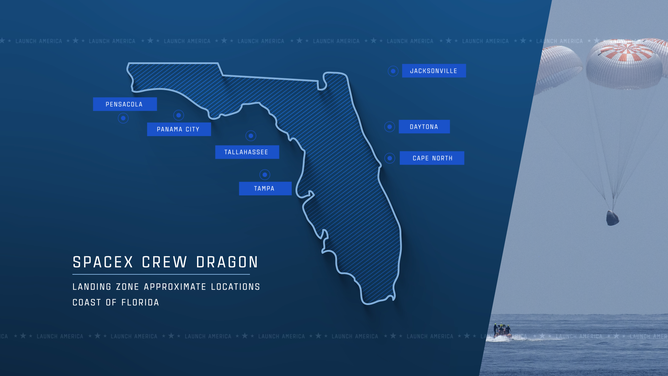
Potential landing areas around Florida for the SpaceX Crew Dragon.
(NASA)
For SpaceX to launch astronauts to space and return them home safely, the weather must meet specific criteria for both events. For liftoff, forecasting by the 45th Weather Squadron begins months in advance. A launch with astronauts is more complicated because the rocket's ascent path needs to have good weather in case of a launch abort.
Unlike the launch, which happens from one location at Kennedy Space Center, the landing can happen in seven areas around the Florida Peninsula, including Pensacola, Tampa, Tallahassee, Panama City, Cape Canaveral, Daytona Beach and Jacksonville.
In August 2020, SpaceX completed the Demo-2 test flight with NASA astronauts Bob Behnken and Doug Hurley, ending with a splashdown off Pensacola. It marked the first landing of its kind in 45 years.
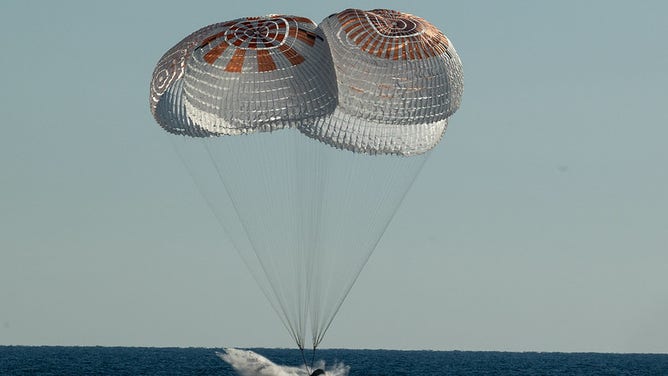
The SpaceX Crew Dragon Freedom spacecraft is seen as it lands with NASA astronauts Kjell Lindgren, Robert Hines, Jessica Watkins, and ESA (European Space Agency) astronaut Samantha Cristoforetti aboard in the Atlantic Ocean off the coast of Jacksonville, Florida, Friday, Oct. 14, 2022. Lindgren, Hines, Watkins, and Cristoforetti are returning after 170 days in space as part of Expeditions 67 and 68 aboard the International Space Station. (Image credit:NASA/Bill Ingalls)
Ahead of the historic Demo-2 mission, NASA provided some insight into selecting a final landing site.
"About two days prior to return, NASA and SpaceX teams will select primary and alternate splashdown target locations from the seven possible sites, with additional decision milestones about where Crew Dragon will splashdown taking place prior to the astronauts boarding the spacecraft, during free flight and before Crew Dragon performs a deorbit burn," NASA wrote in a blog post. "Teams will evaluate the forecasted weather conditions at the primary and alternate splashdown sites at each milestone to determine if the sites are "GO" or "NO-GO" for splashdown and recovery."
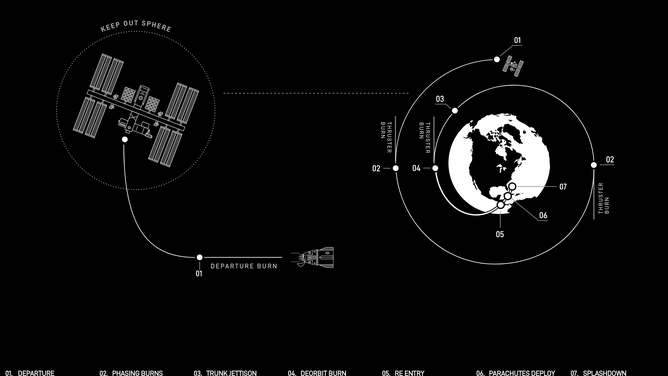
A graphic shows the SpaceX Crew Dragon splashdown sequence
(SpaceX / FOX Weather)
Before the Dragon departs the ISS, teams will narrow the landing site down to a primary location.
NASA has specific criteria for a successful spacecraft recovery, including wind speed no greater than 15 feet per second and wave height no greater than 7 degrees wave slope. According to NASA's landing criteria, lightning must be farther than 10 miles out and rain chances need to be around 25%.
SpaceX continues to monitor the weather before Dragon begins a deorbit burn. At the most intense parts of the return to Earth, the astronauts will experience around 4 G forces.
Dragon uses two sets of parachutes to slow the spacecraft as it blasts through Earth's atmosphere.
One of Dragon Endeavour's main parachutes takes longer to deploy
SpaceX safely landed the Crew-2 astronauts off Florida's coast with the help of a parachute system. One of those chutes took a little longer to deploy.
The spacecraft's Drouge parachutes deploy at about 18,000 feet up, slowing the spacecraft down to 350 mph. The main parachutes deploy at 6,000 feet in the minutes before landing, slowing Dragon down from 119 mph to 15 mph.
The weather around the landing site is essential for the astronauts' safety and the recovery teams waiting to pick up the spacecraft in the water.
SpaceX works with NASA and the U.S. Coast Guard to pick up the spacecraft. Two-speed boats first meet the spacecraft within minutes after landing, and SpaceX's recovery boat then pulls the spacecraft onboard.
The astronauts are out of the capsule, usually within an hour after landing.
